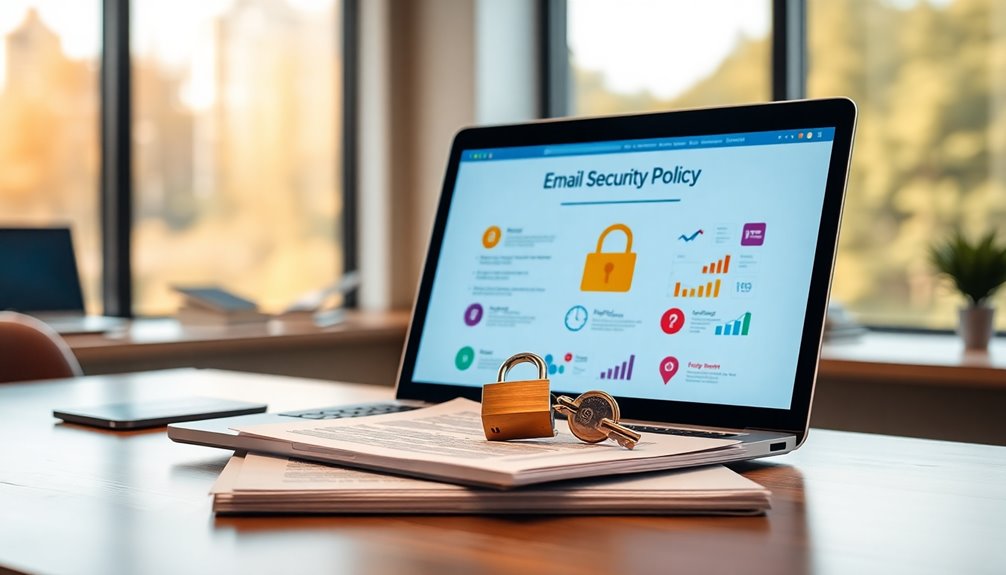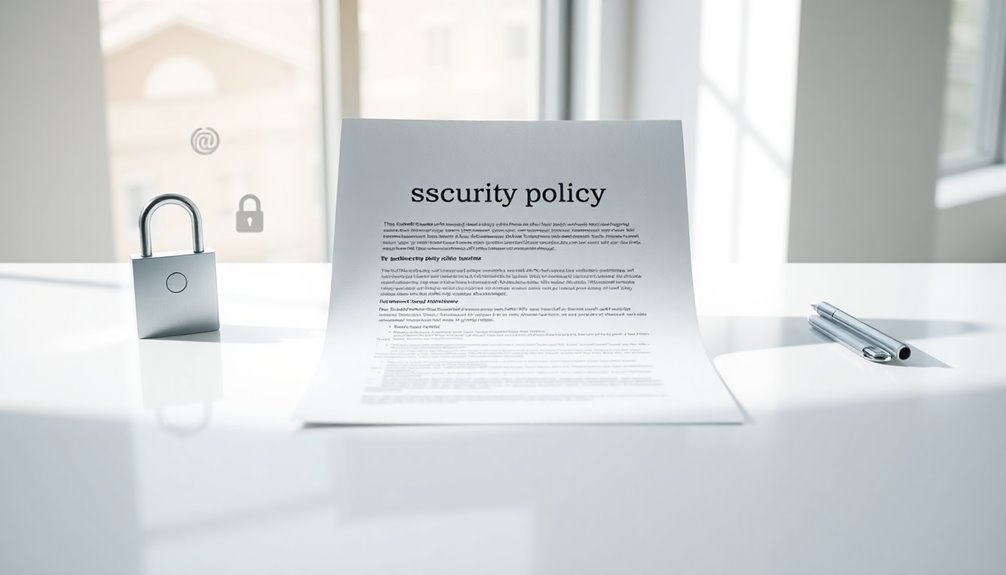An effective email security policy template is crucial for safeguarding your sensitive data against various threats. It should outline acceptable email use, encryption standards, and policies for reporting suspicious activity. To protect your organization, ensure all confidential data transmissions are encrypted and regularly update your antivirus software. Training your employees to recognize phishing attempts helps maintain compliance with regulations and enhances overall security. Regularly revising the policy is key to adapting to new threats. Want to discover how to draft tailored policies and maximize their impact? There are valuable insights just ahead!
Key Takeaways
- Establish clear guidelines for acceptable email use to mitigate risks and protect sensitive information.
- Implement strong password policies, requiring a minimum of eight characters and regular changes every two months.
- Encrypt all confidential data transmissions to ensure unauthorized access is minimized.
- Educate employees on recognizing and reporting phishing attempts to enhance overall cybersecurity awareness.
- Conduct regular audits and updates of anti-virus and anti-malware software to maintain system integrity and effectiveness.
Introduction

In today's digital landscape, email acts as a primary channel for communication, making it essential to have a solid email security policy in place. An Email Security Policy Template serves as a structured framework that outlines the essential protocols for safeguarding your organization's digital correspondence. This template is crucial for protecting sensitive information from various email threats like spam, malware, phishing, and email spoofing.
By implementing a strong email security policy, you can significantly reduce the risk of data breaches while enhancing your organization's overall cybersecurity posture. The template typically includes clear guidelines for acceptable email usage, retention policies, and reporting procedures.
Security measures outlined in the policy ensure compliance with data protection regulations, which are vital for maintaining trust with clients and stakeholders.
Moreover, it's important to regularly update the email security policy and provide employee training to address evolving cyber threats. By doing so, you not only protect sensitive information but also foster a culture of security awareness within your organization.
With the right email security policy in place, you can navigate the complexities of digital communication with confidence and security. With the right email security policy in place, you can navigate the complexities of digital communication with confidence and security. By implementing safeguards like encryption, spam filters, and employee training, you can significantly reduce the risk of phishing attacks and data breaches. Whether you’re negotiating sensitive business deals or writing a confident counter offer, a robust email protocol ensures your communications remain private and professional.
Protecting Sensitive Information Integrity

Protecting the integrity of sensitive information is critical for any organization that relies on email communication. Implementing robust email security measures, like encrypting all confidential data transmissions, ensures unauthorized access is minimized.
Regularly updating your antivirus software and using strong anti-spoofing techniques can significantly reduce the security risk posed by malware and phishing attempts.
Establishing a clear usage policy for email retention and archiving, including a 36-month retention period, safeguards sensitive information while helping you comply with data protection regulations.
Educating your employees about the legal implications of mishandling sensitive information, such as the liabilities associated with unauthorized forwarding, reinforces the importance of maintaining data integrity.
Furthermore, actively monitoring email communications for signs of unauthorized access or suspicious activity is essential.
This proactive approach allows you to quickly identify and address potential threats to sensitive information, enhancing your Incident Management procedures.
Essential Security Measures Included

To maintain a secure email environment, your organization must implement essential security measures. Start by enforcing strong password policies, requiring passwords of at least eight characters that blend letters, numbers, and symbols.
Encourage employees to change their passwords every two months to enhance Email Security.
Make sure your team stays vigilant against malware and phishing attempts. Train them to recognize suspicious emails and report any anomalies immediately.
Regularly updating anti-malware programs will also protect your systems from the latest threats and vulnerabilities.
Utilize email encryption for transmitting sensitive information, ensuring that data travels securely and remains inaccessible to unauthorized users.
This step is crucial to safeguarding your corporate email communications.
Additionally, implement anti-spoofing techniques to identify and drop packets with false source addresses, significantly reducing the risk of email spoofing attacks.
By adhering to these essential security measures, you'll create a robust framework that protects sensitive information and fosters an environment of Acceptable Use.
Drafting Effective Email Policies

Establishing clear email policies lays the groundwork for a secure and efficient communication environment. Your policy should define acceptable and inappropriate use of company email, ensuring everyone understands the boundaries of their digital communication.
This clarity helps foster a culture of security within your organization.
Incorporate specific procedures for email retention and archiving to protect sensitive information and comply with legal regulations. Implementing security measures like mandatory strong passwords and regular updates can significantly reduce the risk of unauthorized access to email accounts.
Educate your team continuously on recognizing phishing attempts and other email threats. This training not only enhances awareness but also prepares employees to act appropriately when faced with potential security breaches.
Pro Tips for Maximizing Impact

Maximizing the impact of your email security policy requires a proactive approach that engages every employee. Start by regularly updating the policy to reflect emerging threats, ensuring it's relevant and effective against cyber risks.
Conduct training sessions to emphasize the importance of spotting phishing attempts and adhering to best practices for email security. This training can significantly reduce the risk of exposing sensitive data and personal information.
Implement strong password policies that require complex passwords changed every two months. Weak passwords are a common vulnerability exploited by cybercriminals, putting your email accounts and secure communication at risk.
Additionally, utilize comprehensive email filtering systems to detect and block spam and malicious content, enhancing your organization's overall information security.
Establish clear consequences for policy violations to reinforce accountability. Make sure employees understand that failing to comply can lead to serious repercussions, emphasizing the importance of vigilance in protecting sensitive information.
Common Mistakes to Avoid

When it comes to email security, avoiding common mistakes is crucial for safeguarding your organization. One major pitfall is neglecting to regularly update your email security policy. Cybercriminals are constantly evolving their tactics, and your policy helps keep pace with these threats.
Additionally, failing to educate employees about the risks of email spoofing and phishing can lead to successful attacks; in 2022, 75% of organizations experienced phishing incidents.
Overlooking strong password policies is another significant mistake. You must require a mix of character types and mandate regular changes every two months to protect sensitive information.
Moreover, not implementing adequate monitoring procedures for suspicious emails hinders your ability to respond swiftly to potential security incidents, exposing your organization to legal liability.
Lastly, excessive personal use of email can increase the risk of data breaches. With 60% of employees admitting to using their work email for personal tasks, you must adhere to strict guidelines to minimize these risks. Furthermore, the implementation of strong email protection measures can significantly reduce the likelihood of successful phishing attacks.
Phishing Prevention Email Template

Phishing attacks pose a serious threat to your organization, often masquerading as legitimate emails to trick users into revealing sensitive information. To combat this, it's crucial to implement a comprehensive phishing prevention email template that aligns with your email security policy. This policy applies to all employees and outlines the importance of safeguarding personal and confidential information.
First, you should use guidelines that educate your team on recognizing phishing attempts. Encourage them to scrutinize email addresses and avoid clicking on unknown links. With proper training, your organization can reduce susceptibility to these attacks by up to 70%.
Additionally, establish a clear reporting procedure for suspected phishing emails. Prompt reporting can mitigate potential damage and enhance overall cybersecurity awareness within your organization.
Regularly update your anti-virus and anti-malware software, as 80% of phishing emails include malicious attachments that can compromise your data.
Final Thoughts

In today's digital landscape, having a robust Email Security Policy is non-negotiable for protecting your organization from various cyber threats. E-mails are a primary communication tool for business purposes, and safeguarding sensitive information within those messages is critical.
By implementing a comprehensive Email Security Policy Template, you can defend against threats like phishing, spoofing, and malware that often target corporate email systems.
Regular training and education for employees enhance awareness, promoting vigilance against potential attacks. Establishing clear guidelines for appropriate email use not only mitigates legal risks but also ensures compliance with data protection regulations. This protects both your organization and its employees.
Additionally, continuous monitoring and regular updates of your Email Security Policy are essential to adapt to the ever-evolving cyber landscape. This proactive approach fosters a culture of accountability and responsibility among your staff, reinforcing your commitment to maintaining data integrity.
Ultimately, a well-structured Email Security Policy not only safeguards your email accounts but also enhances trust within your organization. Prioritizing email security is crucial for preserving sensitive data and ensuring a secure environment for all your business communications.
Frequently Asked Questions
How to Write an Email Security Policy?
Start by defining your policy's purpose and scope. Clearly outline acceptable and unacceptable email usage, security measures, retention procedures, and consequences for violations. Ensure everyone understands their responsibilities to maintain a secure email environment.
What Are the 3 Email Safety Rules to Stay Safe?
To stay safe with email, always verify the sender's address, use strong, unique passwords, and enable two-factor authentication. These steps significantly reduce your risk of falling victim to phishing and other email threats.
How Can an Email Protection Tool Help Keep Your Inbox Safe?
An email protection tool keeps your inbox safe by blocking up to 99% of malicious emails, using machine learning for improved detection, encrypting sensitive information, and providing real-time monitoring to address threats quickly.
How Can Emails Be Protected From Security Breaches by the Following?
You can protect your emails from security breaches by using strong passwords, updating antivirus software regularly, encrypting sensitive information, employing anti-spoofing measures, and establishing clear guidelines for reporting suspicious emails promptly.









